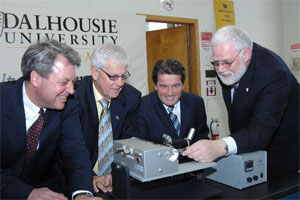 |
Professor of Chemical Engineering, Dr. Michael Pegg (far right) demonstrates a tensiometer, used in carbon storage research. Also in the photo are Andrew Henry, director of the Carbon Storage Research Consortium, Nova Scotia Minister of Energy Richard Hurlburt and Minister of Natural Resources Gary Lunn.(Danny Abriel Photo) |
Carbon capture and storage (CCS) is a technology used to capture and store carbon dioxide (CO2) emissions from large power plants—thereby preventing the emissions from reaching the atmosphere.
On Wednesday, April 23, the federal government announced $5 million for research into the potential for carbon dioxide storage in Nova Scotia. The announcement was made at the Faculty of Engineering at Dalhousie University.
In a province that relies primarily on the burning of fossil fuels for electricity generation, it’s important to reduce carbon dioxide emissions and their environmental impacts.
“No question, the health of our environment is at the top of the list,” said Natural Resources Canada Minister Gary Lunn. “Coal is an important resource, especially in Nova Scotia where it represents more than 75 per cent of our generating capacity … We need that energy, we need the economic benefits, but we must find a way to produce and consume that energy a lot cleaner than we do today.”
While the technology to capture carbon is available, storage is an independent issue for each project. In Western Canada, geological storage is underway, but more research must be done in Nova Scotia. “We need to know if our basins contain suitable features for the storage of carbon,” said Richard Hurlburt, Nova Scotia Minister of Energy.
The $5 million will be administered by the Carbon Storage Research Consortium, a joint partnership comprising Dalhousie University, Nova Scotia Power and the NS Department of Energy. Through this consortium, researchers from Dalhousie, other universities, industry, government, and consultants, will assess the viability of carbon dioxide storage in Nova Scotia.
Dalhousie’s Dean of Science, Keith Taylor, explains that the Faculties of Engineering and Science will do much of the research, but researchers from other institutions will also be called on for their expertise.
The research will benefit the the environment, and students as well: “For Dalhousie, it’s well within our mission to conduct such research to advance scientific understanding for the good of society. It will be tremendously inspirational for the students who will be engaged as members of the research teams,” says Dr. Taylor.
Even with its promise of providing cleaner energy, CCS is not an alternative to renewable energy sources, such as tidal, solar and wind power.
“The logical approach to CO2 management is to use less fossil fuel and use it efficiently,” says Andrew Henry, director, Carbon Storage Research Consortium. “This technology will allow us to continue using fossil fuels over the next 50 years, while we continue to investigate new energy sources.”
Billy Comeau is an NSCC student on internship with Dalhousie’s Communications and Marketing Department.
